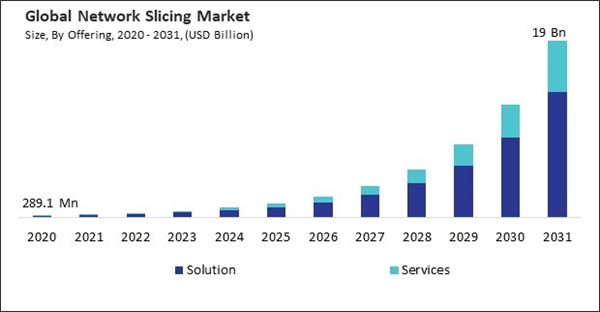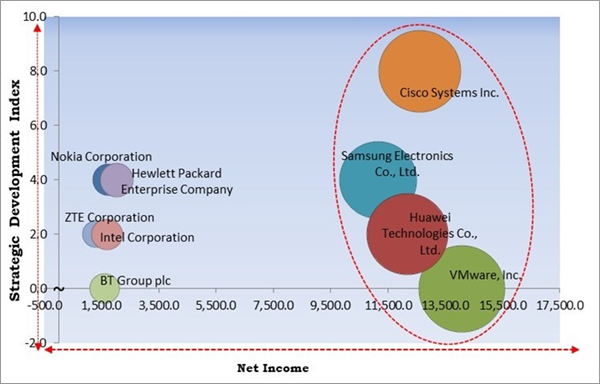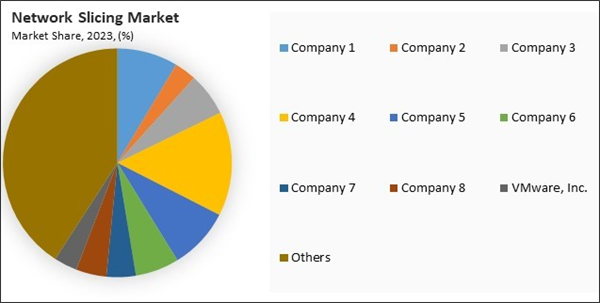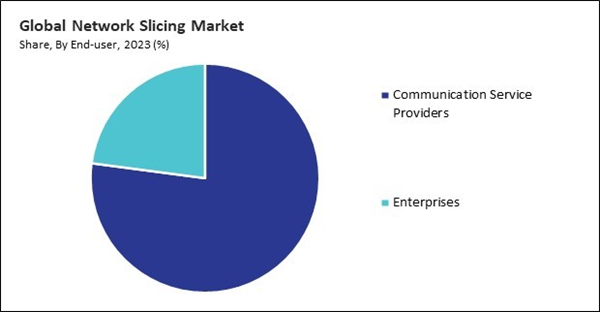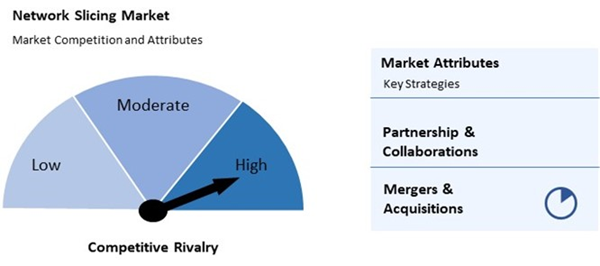The Global Network Slicing Market size is expected to reach $19 billion by 2031, rising at a market growth of 50.2% CAGR during the forecast period.
Government agencies require reliable, secure, high-performance networks to deliver critical services to citizens, such as emergency response, public safety, and healthcare. Thus, the government segment acquired $140.9 million revenue in 2023. Network slicing can ensure that these services receive dedicated network resources, prioritization, and quality of service guarantees. Many governments are investing in smart city initiatives, which rely on connected devices and sensors to improve city services and infrastructure.
The major strategies followed by the market participants are Partnerships as the key developmental strategy to keep pace with the changing demands of end users. For instance, In, February 2024, Ericsson AB came into partnership with Telstra. Through this partnership, both companies would provide a world-class infrastructure and solutions in delivering 5G network slicing services tailored for Australian enterprises. Additionally, In, February 2024, ZTE Corporation collaborated with Red Hat. This collaboration seeks to empower service providers to achieve cloud-native, high-performance networks for the swift deployment of 5G service applications.
Additionally, Edge computing is a rapidly growing trend in technology, driven by the need to process data closer to where it is generated. It is crucial in supporting edge computing by providing dedicated resources at the network's edge. Thus, the expansion of edge computing also supports the development of the market.
The leading players in the market are competing with diverse innovative offerings to remain competitive in the market. The above illustration shows the percentage of revenue shared by some of the leading companies in the market. The leading players of the market are adopting various strategies in order to cater demand coming from the different industries. The key developmental strategies in the market are Partnerships & Collaborations.
Competition in the network slicing market is intense as telecom giants like Ericsson, Huawei, and Nokia vie for dominance. Startups and cloud service providers also enter the fray with innovative solutions. Regulatory policies and standardization efforts shape the landscape, fostering a dynamic ecosystem focused on optimizing network resources for diverse user needs.
Government agencies require reliable, secure, high-performance networks to deliver critical services to citizens, such as emergency response, public safety, and healthcare. Thus, the government segment acquired $140.9 million revenue in 2023. Network slicing can ensure that these services receive dedicated network resources, prioritization, and quality of service guarantees. Many governments are investing in smart city initiatives, which rely on connected devices and sensors to improve city services and infrastructure.
The major strategies followed by the market participants are Partnerships as the key developmental strategy to keep pace with the changing demands of end users. For instance, In, February 2024, Ericsson AB came into partnership with Telstra. Through this partnership, both companies would provide a world-class infrastructure and solutions in delivering 5G network slicing services tailored for Australian enterprises. Additionally, In, February 2024, ZTE Corporation collaborated with Red Hat. This collaboration seeks to empower service providers to achieve cloud-native, high-performance networks for the swift deployment of 5G service applications.
Cardinal Matrix - Market Competition Analysis
Based on the Analysis presented in the Cardinal Matrix; Cisco Systems Inc., Samsung Electronics Co., Ltd., Huawei Technologies Co., Ltd., and VMware, Inc. are the forerunners in the Network Slicing Market. In September 2023, Samsung Electronics Co., Ltd. signed a collaboration with KDDI, a leading telecommunications operator in Japan, providing a wide range of services including mobile, fixed-line, and internet solutions. Under this collaboration, both companies would introduce various commercial 5G network slicing services and explore novel business models enabled by this groundbreaking technology. Companies such as Hewlett Packard Enterprise Company, Nokia Corporation, Intel Corporation are some of the key innovators in Network Slicing Market.Market Growth Factors
Different applications and services have varying bandwidth, latency, reliability, and security requirements. For example, streaming video services may prioritize high bandwidth, while real-time applications like telemedicine require low latency and high reliability. Therefore, the growing demand for customized services is significantly boosting the growth of the market.Additionally, Edge computing is a rapidly growing trend in technology, driven by the need to process data closer to where it is generated. It is crucial in supporting edge computing by providing dedicated resources at the network's edge. Thus, the expansion of edge computing also supports the development of the market.
Market Restraining Factors
Implementing network slicing involves significant investment in upgrading and modernizing network infrastructure. This may include deploying software-defined networking (SDN) controllers, virtualized network functions (VNFs), and cloud-native architectures to support the dynamic creation and management of network slices. Thus, the high initial investment required for implementing network slicing can hinder its widespread adoption.The leading players in the market are competing with diverse innovative offerings to remain competitive in the market. The above illustration shows the percentage of revenue shared by some of the leading companies in the market. The leading players of the market are adopting various strategies in order to cater demand coming from the different industries. The key developmental strategies in the market are Partnerships & Collaborations.
Application Outlook
By offering, the market is bifurcated into solution and services. The solution segment acquired a 74.2% revenue share in the market in 2023. Network slicing solutions provide businesses with greater control and visibility over their network resources. These solutions typically include software-defined networking (SDN) and network functions virtualization (NFV) technologies, which allow businesses to dynamically allocate and manage network resources. Network slicing solutions also offer enhanced security.End-user Outlook
Based on end-user, the market is characterized into communication service providers and enterprises. In 2023, the enterprises segment procured a significant 23% revenue share in the market. It offers enterprises a way to create more agile, efficient, and secure networks that can better support their business objectives.Vertical Outlook
On the basis of vertical, the market is classified into healthcare, government, transportation & logistics, energy & utilities, manufacturing, media & entertainment, financial services, retail, and others. The healthcare segment acquired a 22% revenue share in the market in 2023. Healthcare data is highly sensitive and requires stringent security measures. It can create isolated networks for healthcare data, ensuring that patient information remains confidential and protected from unauthorized access.By Regional Analysis
Region-wise, the market is analyzed across North America, Europe, Asia Pacific, and LAMEA. The North America segment procured a 37% revenue share in the market in 2023. North America is one of the leading regions in market size and growth for market.Market Competition and Attributes
Competition in the network slicing market is intense as telecom giants like Ericsson, Huawei, and Nokia vie for dominance. Startups and cloud service providers also enter the fray with innovative solutions. Regulatory policies and standardization efforts shape the landscape, fostering a dynamic ecosystem focused on optimizing network resources for diverse user needs.
Recent Strategies Deployed in the Market
- Feb-2024: ZTE Corporation collaborated with Red Hat, a leading provider of open-source solutions, including the Red Hat Enterprise Linux operating system and a wide range of middleware, applications, and management solutions. This collaboration seeks to empower service providers to achieve cloud-native, high-performance networks for the swift deployment of 5G service applications.
- Feb-2024: Ericsson AB came into partnership with Telstra, a leading Australian telecommunications company providing a range of services including mobile, internet, and entertainment. Through this partnership, both companies would provide a world-class infrastructure and solutions in delivering 5G network slicing services tailored for Australian enterprises.
- Jan-2024: Hewlett Packard Enterprise Company acquired Juniper Networks, a leading provider of networking solutions, delivering innovative and reliable infrastructure for businesses worldwide. This acquisition would expand HPE's networking business, by combining HPE's and Juniper's technology capabilities.
- Dec-2023: Nokia Corporation took over Fenix Group, a leading provider of innovative solutions in defense, security, and aerospace. Through this acquisition, integrating Fenix's tactical communications capabilities would enable Nokia to provide a broader range of solutions to its defense clientele.
- Oct-2023: Huawei Technologies Co., Ltd. signed a collaboration with Etisalat by e&, a telecommunications company known for its innovative services and expansive network coverage in the Middle East and Africa. Under this collaboration, both companies would bring transformative advantages to the vertical industries of the United Arab Emirates, signifying a groundbreaking advancement for etisalat by e& in the journey towards commercializing Network-as-a-Service.
List of Key Companies Profiled
- Ericsson AB
- Samsung Electronics Co., Ltd. (Samsung Group)
- Nokia Corporation
- Huawei Technologies Co., Ltd. (Huawei Investment & Holding Co., Ltd.)
- ZTE Corporation
- Cisco Systems Inc.
- Hewlett Packard Enterprise Company
- Intel Corporation
- VMware, Inc. (Broadcom Inc.)
- BT Group plc
Market Report Segmentation
By Application- Solution
- Services
- Communication Service Providers
- Enterprises
- Healthcare
- Transportation & Logistics
- Energy & Utilities
- Manufacturing
- Media & Entertainment
- Financial Services
- Retail
- Government
- Others
- North America
- US
- Canada
- Mexico
- Rest of North America
- Europe
- Germany
- UK
- France
- Russia
- Spain
- Italy
- Rest of Europe
- Asia Pacific
- China
- Japan
- India
- South Korea
- Singapore
- Malaysia
- Rest of Asia Pacific
- LAMEA
- Brazil
- Argentina
- UAE
- Saudi Arabia
- South Africa
- Nigeria
- Rest of LAMEA
Table of Contents
Chapter 1. Market Scope & Methodology
Chapter 2. Market at a Glance
Chapter 3. Market Overview
Chapter 4. Competition Analysis - Global
Chapter 5. Global Network Slicing Market by Offering
Chapter 6. Global Network Slicing Market by End-user
Chapter 7. Global Network Slicing Market by Vertical
Chapter 8. Global Network Slicing Market by Region
Chapter 9. Company Profiles
Companies Mentioned
- Ericsson AB
- Samsung Electronics Co., Ltd. (Samsung Group)
- Nokia Corporation
- Huawei Technologies Co., Ltd. (Huawei Investment & Holding Co., Ltd.)
- ZTE Corporation
- Cisco Systems Inc.
- Hewlett Packard Enterprise Company
- Intel Corporation
- VMware, Inc. (Broadcom Inc.)
- BT Group plc
Methodology

LOADING...



